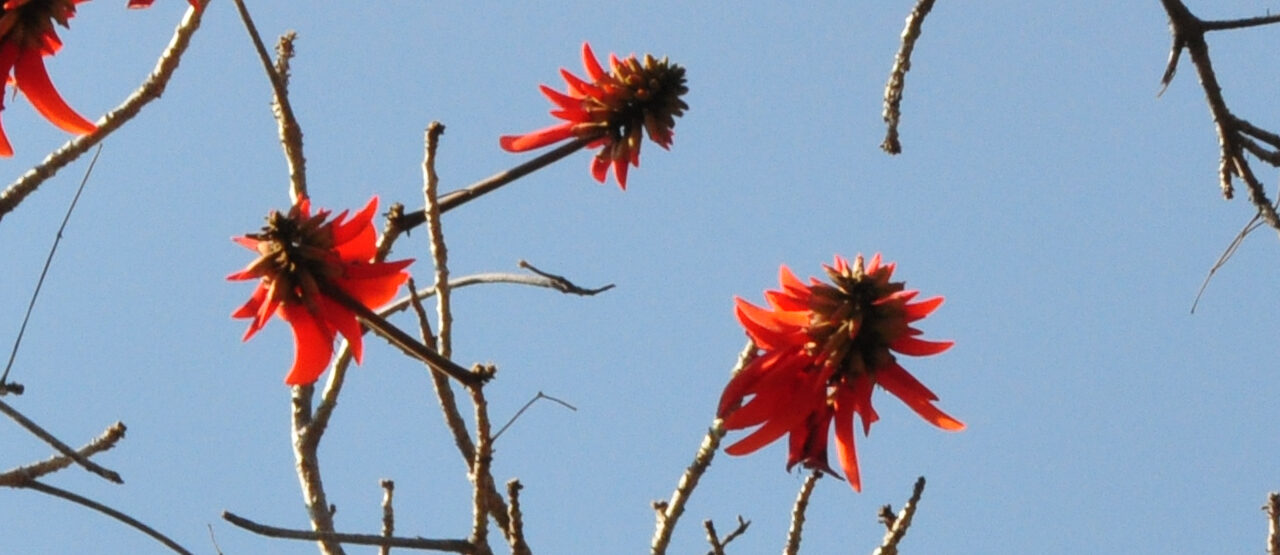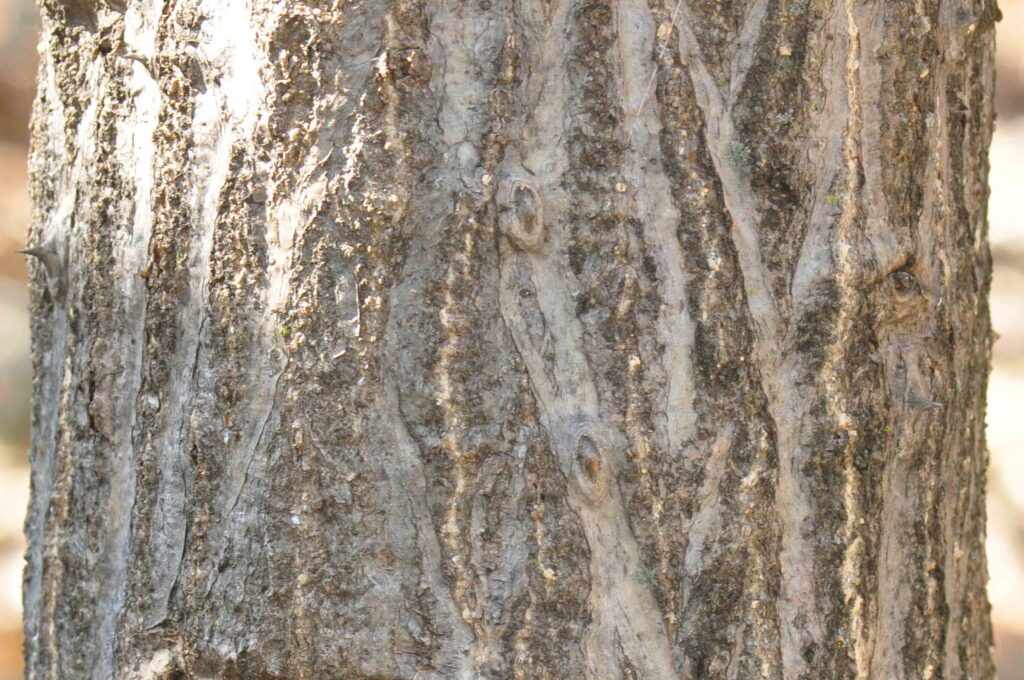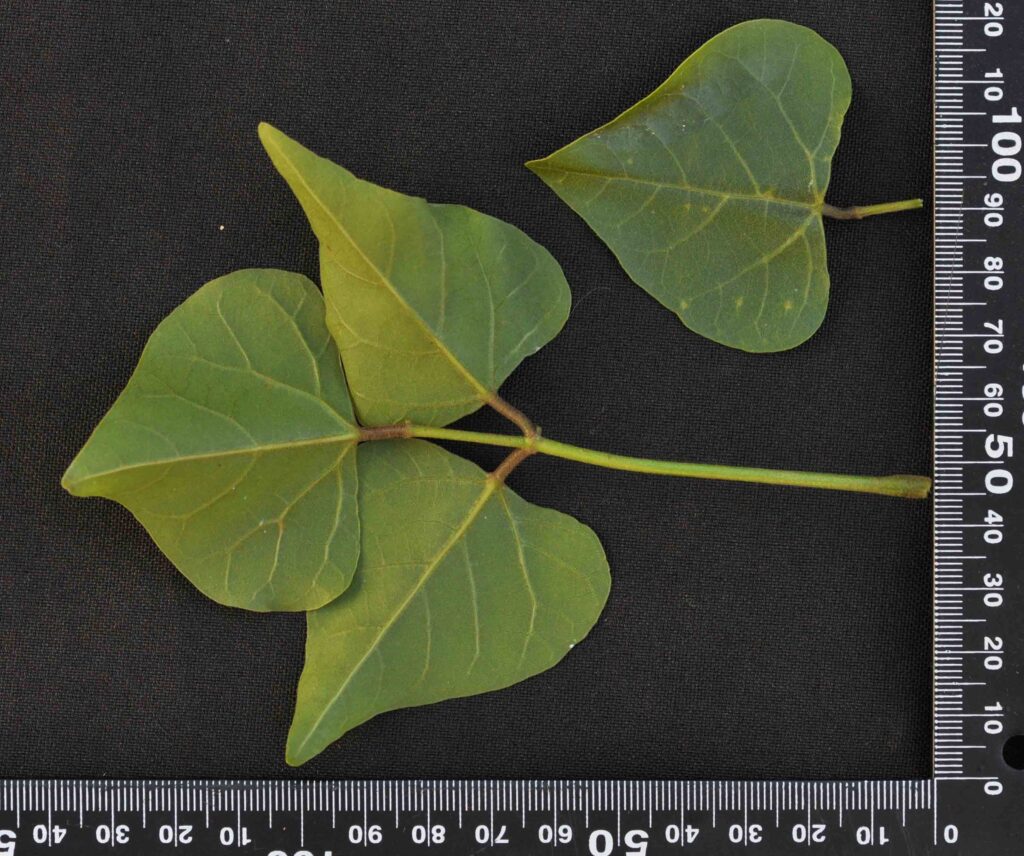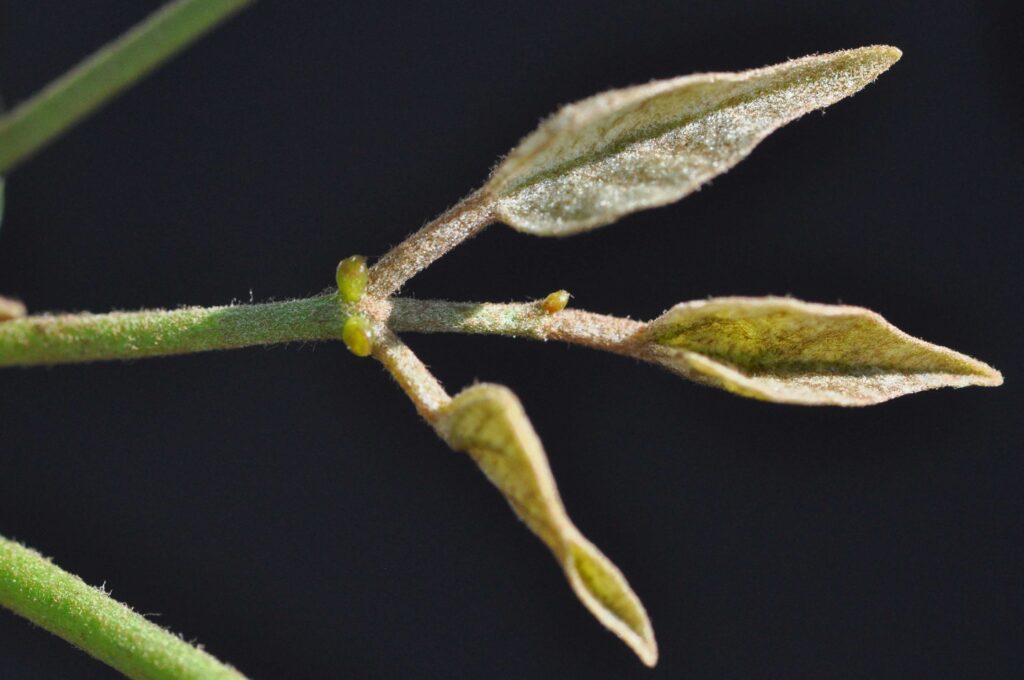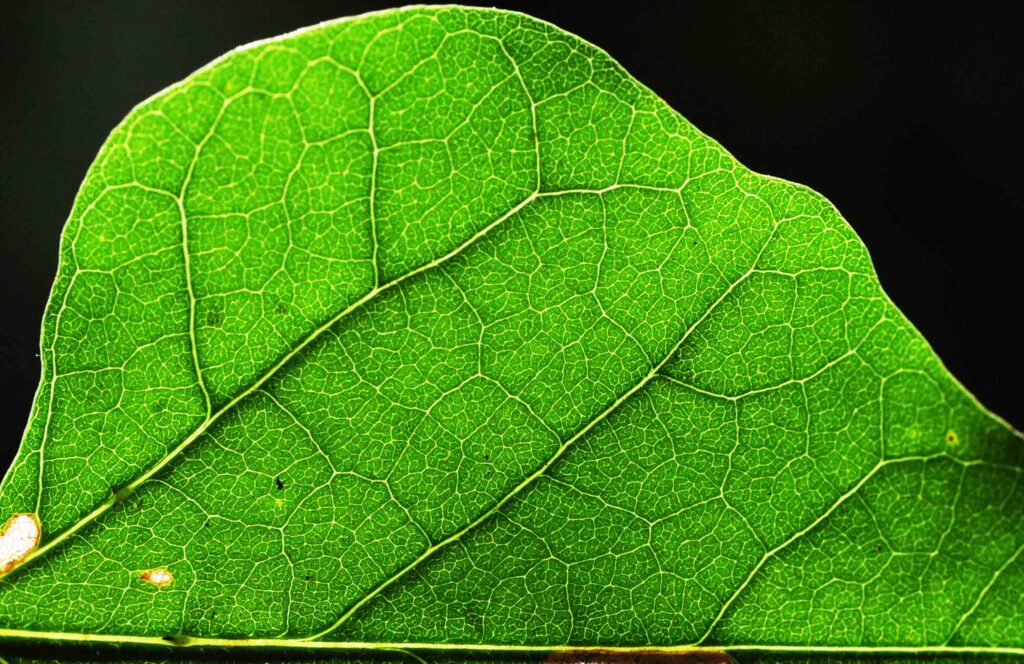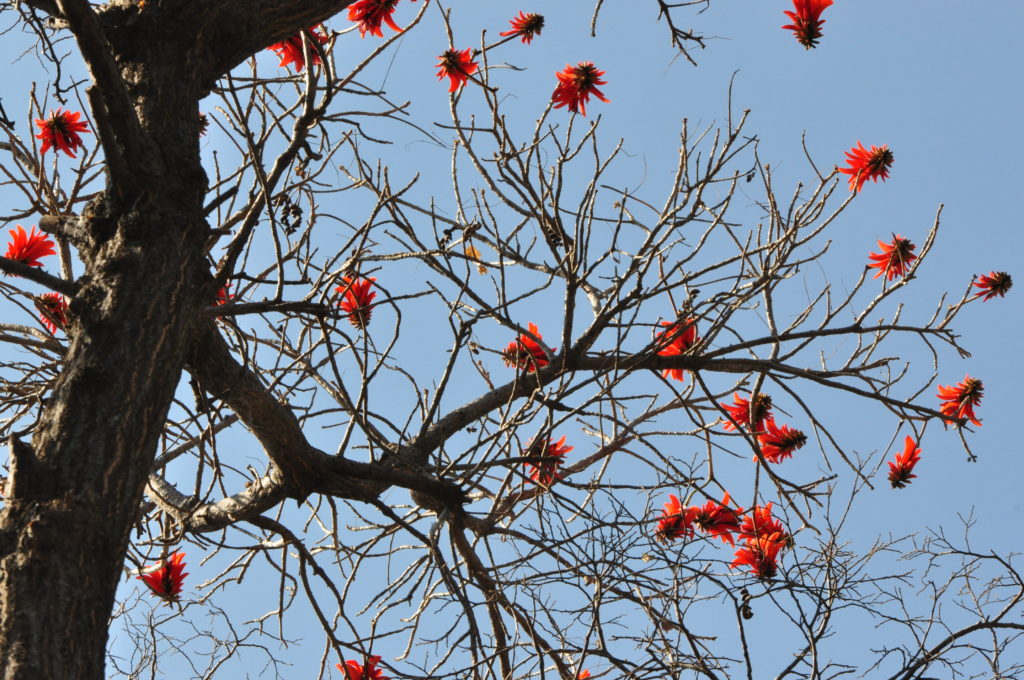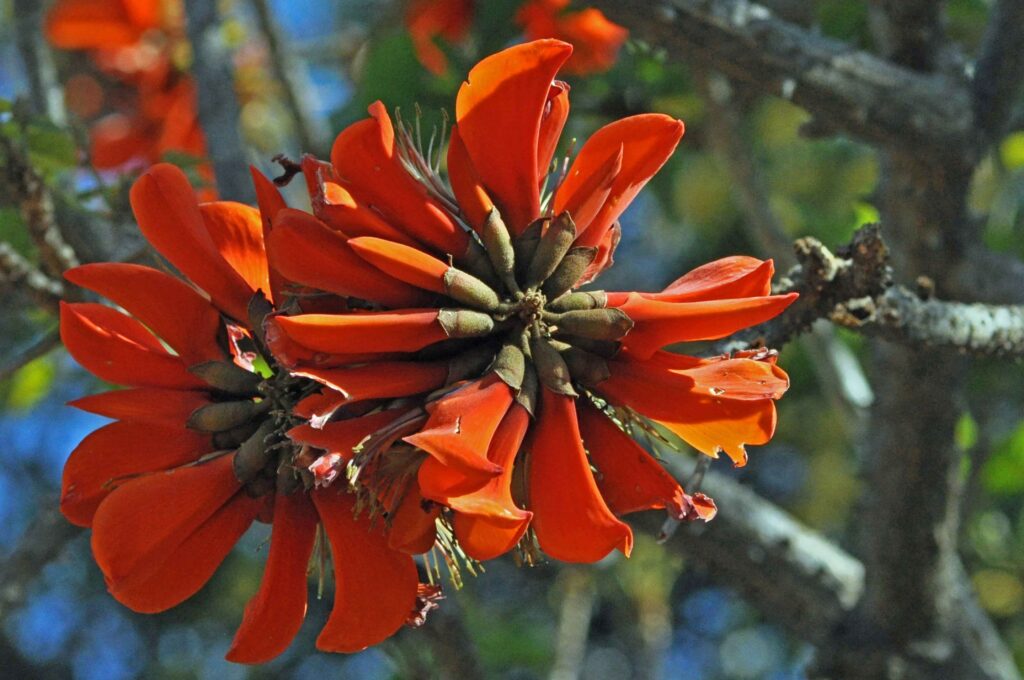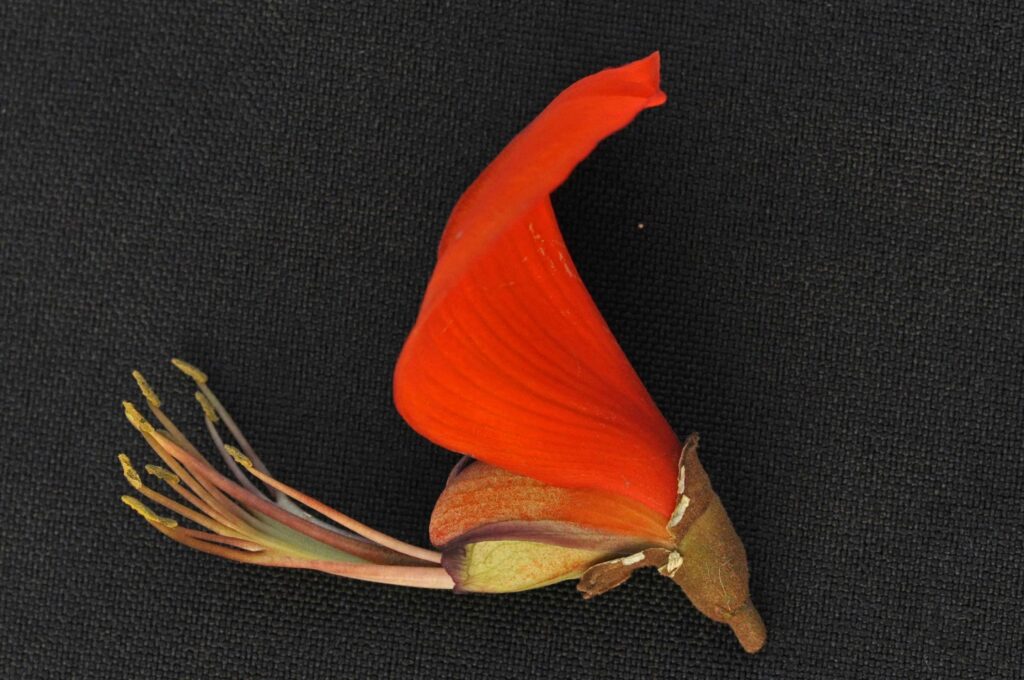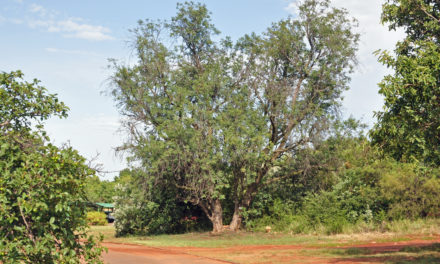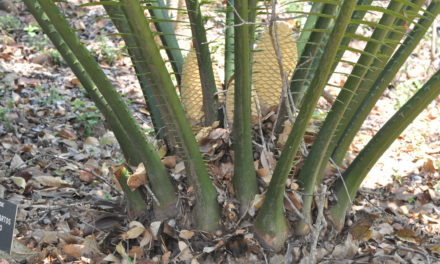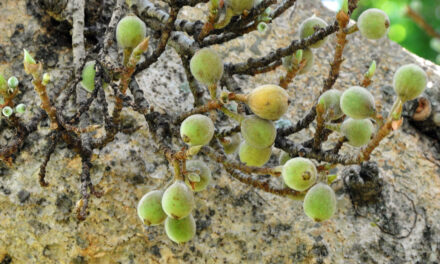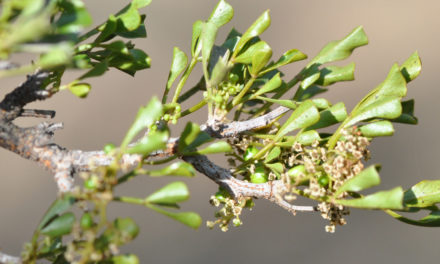General Info – summary
This deciduous Tree has pale bark and is up to 20m high. Branchlets have prickles. Leaves are trifoliate and leaflets are entire & have a pair of glands at the base. Impressive 5-merous, reddish, zygomorphic Flowers, are bisexual, and in racemes. Visible stamens: 10 (with 1 free), dehisce longitudinally. The stalked, superior ovary has a protruding style. Fruit is a pod, constricted between the orange/red seeds.
Description
Erythrina caffra
Previous Names: Erythrina constantiana, Erythrina fissa.
SA Tree No. 242.
Common names: (Afr) Dopkraal, Koraalboom, Koraalboom, Kurkboom, Kurkboombos, Kuskoraalboom, Kus-koraalboom. (Eng) Cape Coral Tree, Coastal Coral Tree, Cocky-doodles, Coral Tree, Lucky Bean Tree. (isiXhosa) Umsintsi. (isiZulu) Umsintsi.
Family: Fabaceae, or Leguminosae (Pea, bean or legume family). After the Orchidaceae and the Asteraceae, the Fabaceae is the third largest Angiosperm (flowering plants) family with 700+ genera and close to 20 000 species. Local Tree genera on this website include Acacia (Vauchellia, Senegalia), Albizia, Bauhinia, Bolusanthus, Burkea, Calpurnia, Colophospermum, Cordyla, Cyclopia, Dichrostachys, Erythrina, Erythrophleum, Faidherbia, Indigofera, Mundulea, Peltophorum, Philenoptera, Piliostigma, Schotia and Xanthocercis. The Fabaceae are recognisable by their fruit and by their pinnately compound Leaves. Leaves may also be simple – even bilobed and usually have stipules – some of which may be spinescent. Leaflets are usually entire. Flowers are bisexual and bracteate. Regular flowers usually have 4-5 sepals and the same number of petals. Irregular flowers have 4-5 sepals and 5 or less petals. Stamens have anthers that have 2 pollen sacs and there are usually at least twice the number of stamens as petals – often 10. The superior Ovary has 1 locule containing 1 or more ovules. The Stigma and Style are simple. The single carpel develops into the Fruit, which is usually a pod. The fallen pods may break into segments. Seeds vary.
Name derivation: Erythrina – from the Greek “erythros” meaning red: referring to the flower colour. caffra – refers to south eastern Cape. The genus Erythrina has about 160 species with 9 in southern Africa and 6 in the South Africa.
Conservation: National Status: L C. (Least Concern). Assessment Date: 2005 (W. Foden and L. Potter).
Tree
The height of this Tree, with its spreading crown, is environmentally dependent. In the forests it may reach 20m high but is usually less than half this in the open. In the relatively smooth Stem (main axis of the plant, the leaf and flower bearing as distinguished from the root-bearing axis), the pale, Barked trunk is shallowly longitudinal fissured (photo 502). In this photo, short sharp Prickles are visible (photo 502 LHS). Prickles also occur on the branches.
- 502. 2017/08/15 Pretoria NBG. Photo: David Becking.
Leaves
On this deciduous tree, the initially finely hairy Leaves are trifoliate (compound leaf with 3 leaflets). The terminal (central) leaflet is slightly larger – up to 16 x 18cm (photo 561 + upper right). The broadly ovate to elliptic Leaflets taper towards the apex and may be somewhat heart-shaped. Unlike the terminal leaflet, the base of the 2 lower leaflets is asymmetric (not equal to the opposite side). Leaflets have a pair of Glands at the base (photo 558). The Vein structure is best observed when the leaf is viewed against a strong light (photo 145). Here the lateral veins arch and join prior to reaching the margin. The leaflet Margins are entire (with a continuous margin). The young slender Petiole (leaf stalk) is long, initially hairy and mature leaflets lack both hairs and prickles. Petiolules (stalks of leaflets) are present (photo 561). Stipules (basal appendage of the petiole) fall early. Bracts (modified leaf associated with reproductive structures) are present.
- 561. 2019/09/10. Linden. Photo: David Becking.
- 558. 2019/.09/10. Linden. Photo: David Becking.
- 145. 2018/03/14 Pretoria NBG. Photo: David Becking.
Flowers
The most impressive, odourless Flowers usually develop before the new leaves (photo 504). The large, usually orange-scarlet, bisexual flowers are Zygomorphic (irregular flower: when corolla is divisible into 2 equal halves in one plane only). The flowers are 5-merous (floral parts in 5’s). They may occur in almost upside down, dense, and broad Racemes (a simple elongated inflorescence with stalked flowers that open in succession towards the apex – photo 504). Each raceme may contain up to 80 individual flowers. The Calyx is grey/brown and its minutely hairy base is tubular (photo 551). The Corolla has petals that range from orange to scarlet (photo 504) and some trees have flowers that are cream coloured. Here the conspicuous backward curving vexillum, (standard or banner petal) is broad, short and reflexed (photo 541) so that the stamens are visible. (This is an important difference between Erythrina caffra and E. lysistemon. The latter has a longer, narrower vexillum which folds and encloses the stamens). The 2 Wing petals and the 2 joined Keel petals are up to 2,5cm long. The 10 Stamens (nine joined and one free – photo 541) have uniform, centrally attached Anthers that dehisce longitudinally. The stalked superior Ovary contains many ovules and has a long Style. The Stigma has a small head (Jun-Sep).
- 504. 2017/08/15 Pretoria NBG. Photo David Becking.
- 551. 2019/09/10 Linden. Photo David Becking.
- 541. 2019/09/10. Linden. Photo (dissected): David Becking.
Fruit
The fruit is similar to Erythrina lysistemon. It is a dehiscent, hairless, large and dark coloured cylindrical Pod, up 7cm long, and constricted between Seeds. The extended remains of the style is visible. Older seeds are orange or bright red with a black area around the Hilum (scar or mark left on the seed coat indicating the place of attachment to the ovary wall). (Oct-Dec).
Distribution & Ecology
These plants are commonly found in moist coastal forests and wooded streams, in deep sandy soil and near rivers along the Indian Ocean coastal region of low or free areas. Places where it is occurs naturally include the Eastern Cape from Humansdorp (slightly west of Port Elizabeth) and the Amatola montains (north of Buffalo City). They also occur in KwaZulu-Natal as far north as Hlabisa, Lake Sibayi and possibly Inhaca Island – just east of Maputo in Mozambique. It is thus Endemic in southern Africa. The flowers of this tree produce plentiful Nectar that attracts insect and bird pollinators including sunbirds, yellow weavers, starlings, orioles and bulbuls. Old wood is soft and is an ideal nesting place for woodpeckers and barbets. The trees can withstand some frost. They do not form a dense shade, and this allows other plants to grow beneath them. The tree has been introduced into India and is the official tree of Los Angeles in the USA. In SA, the distribution is similar to that of Acokanthera oblongifolia.
Ethnobotany
The low-density, greyish Wood is light, spongy and used for small boats, brake-blocks and fishing floats. Tarred wood may be used to make roof shingles. Some people believe that the tree attracts lightning. The flowering tree is also used as an indicator of when to plant crops. Before planting the Seeds, they should be soaked in warm water for a couple of days. Select those that have sunk for planting and allow them to dry. Do this shortly after collecting. Truncheons (stem cutting from a selected plant – used to produce genetically identically new plants) are easy to grow. Plant in full sun. This is an attractive light shade tree and requires moderate water. Many trees have been planted to control the movements of animals. The bright red Seeds are used as lucky beans and necklaces. However, they do contain poisonous alkaloids and should not be consumed.
References
Boon, R. 2010. Pooley’s Trees of eastern South Africa. Flora and Fauna Publications Trust, Durban.
Burrows, J.E., Burrows, S.M., Lotter, M.C. & Schmidt, E. 2018. Trees and Shrubs Mozambique. Publishing Print Matters (Pty) Ltd. Noordhoek, Cape Town.
Coates Palgrave, M. 2002. Keith Coates Palgrave Trees of Southern Africa, edn 3. Struik, Cape Town.
Foden, W. & Potter, L. 2005. Erythrina humeana Spreng. National Assessment: Red List of South African Plants version 2020.1. Accessed on 2023/05/04.
van Wyk, B. & van Wyk, P. 1997 Field guide to Trees of Southern Africa, Struik, Cape Town.
Ginn, P. J, McIlleron, W.G, & Mimstein, P. le S. 1991. The Complete Book of South African Birds. Struik, Cape Town/Singapore.
http://pza.sanbi.org/erythrina-caffra
https://en.wikipedia.org/wiki/Erythrina_caffra

